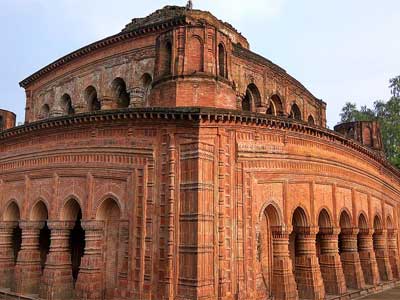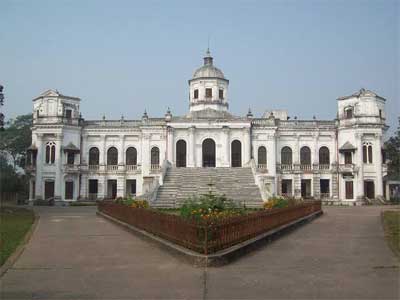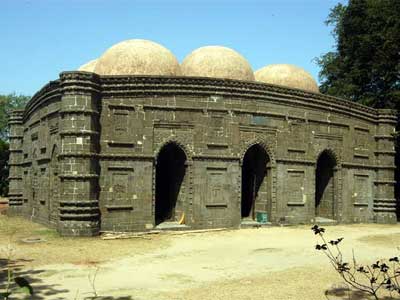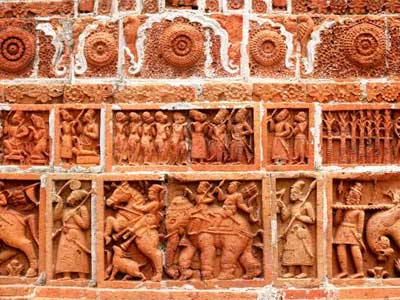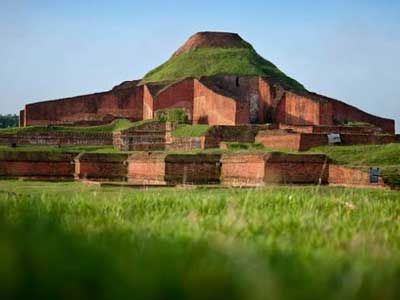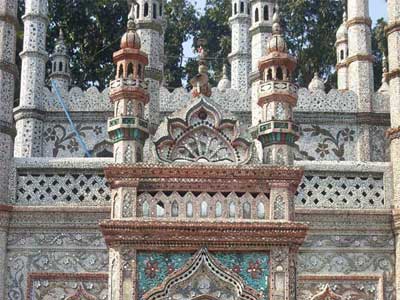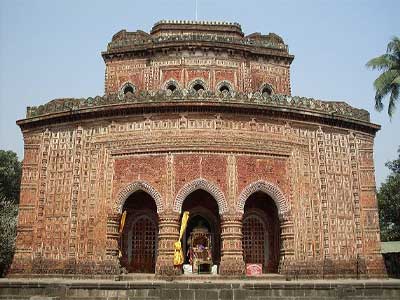Archaeological Sites and Monuments
Bangladesh is a country considerably rich in archaeological wealth, especially of the medieval period both during the Muslim and pre-Muslim rules, though most of it is still unexplored and unknown. In archaeological fieldwork and research this area was very much neglected for a long time for various reasons, not the least of which are its difficult geography and climate and remoteness from the main centres of the subcontinent. With the independence of Bangladesh in 1971 the Government has undertaken a number of field projects including a comprehensive survey and exploration of the hitherto unexplored areas and a fairly ambitious scheme of excavations on selected sites. Though work at present is carried out on a limited scale, the discoveries already made have been significant. while new information and fresh evidence are coming out gradually. These fresh explorations are likely to add substantially to our knowledge of the history and chronology of ancient Bangladesh and various aspects of her life and culture. The earlier history of Bangladesh reveals that Buddhism received royal patronage from some important ruling dynasties like the great Pala rulers. the Chandras and the Deva Kings. Under their royal patronage numerous well-organized, self-contained monasteries sprang up all over the country. The major archaeological sites are described below.
- Paharpur
- Mahasthangarh
- Mainamati
- Lalbagh Fort
- Shait-Gumbad Mosque, Bagherhat
- Sonargaon
- Kantanagar Temple, Dinajpur
Paharpur is a small village 5 km. west of Jamalganj in the greater Rajshahi district where the remains of the most important and the largest known monastery south of the Himalayas has been excavated. This 7th century archaeological find covers approximately an area of 27 acres of land. The entire establishment, occupying a quadrangular court; measuring more than 900 ft. externally on each side, has high enclosure-walls about 16 ft. in thickness and from 12 ft. to 15 ft. in height. With elaborate gateway complex on the north, there are 45 cells on the north and 44 in each of the other three sides with a total number of 177 rooms. The architecture of the pyramidal cruciform temple is profoundly influenced by those of South- East Asia, especially Myanmar and Java.
A small site-museum built in 1956-57 houses the representative collection of objects recovered from the area. The excavated findings have also been preserved at the Varendra Research Museum at Rajshahi.
The antiquities of the museum include terra-cotta plaques, images of different gods and goddesses, potteries, coins, inscriptions, ornamental bricks and other minor clay objects.
Mahasthan, the oldest archaeological site of Bangladesh is on the western bank of river Karatoa 18 km, north of Bogra town beside Bogra-Rangpur Road. The spectacular site is an imposing landmark in the area having a fortified. oblong enclosure measuring 5000 ft. by 4500 ft. with an average height of 1 5 ft. from the surrounding paddy fields. Beyond the fortified area. other ancient ruins fan out within a semicircle of about five miles radius. Several isolated mounds, the local names of which are Govinda Bhita Temple, Khodai Pathar Mound, Mankalir Kunda, Parasuramer Bedi, Jiyat Kunda etc. surround the fortified city.
This 8th century archaeological site is still held to be of great sanctity by the Hindus. Every year ( mid-April ) and once in every 12 years (December) thousands of Hindu devotees join the ceremony on the bank of river Karatoa. A visit to the Mahasthangarh site museum will open up for you wide variety of antiquities, ranging from terra-cotta objects to gold ornaments and coins recovered from the site.
For visiting Paharpur and Mahasthangarh. the visitors may enjoy the hospitality of Parjatan Motel at Bogra. Mahasthangarh and Paharpur are only 18 km. and 75 km. respectively from Bogra town.
Rajshahi is famous for pure silk. Silk processing industry of the Seri-Culture Board is just ten minutes walk from Parjatan Motel at Rajshahi. Besides the Seri-Culture Board, a visit to Varendra Research Museum at the heart of the city for archaeological finds, would be most rewarding.
An isolated low, dimpled range of hills. dotted with more than 50 ancient Buddhist settlements of the 8th to 12th century AD known as Mainamati-Lalmai range are extended through the centre of the district of Comilla.
Salban Vihara, almost in the middle of the Mainamati-Lalmai hill range consists of 115 cells. built around a spacious courtyard with cruciform temple in the centre facing its only gateway complex to the north resembling that of the Paharpur Monastery.
Kotila Mura situated on a flattened hillock. about 5 km. north of Salban Vihara inside the Comilla Cantonment area is picturesque Buddhist establishment. Here three stupas are found side by side representing the Buddhist “Trinity” or three jewels i.e. the Buddha, Dharma and Sangha.
Charpatra Mura is an isolated small oblong shrine situated about 2.5 km. north-west of Kotila Mura stupas. The only approach to the shrine is from the East through a gateway which leads to a spacious hall.
The Mainamati site Museum has a rich and varied collection of copper plates, gold and silver coins and 86 bronze objects. Over 150 bronze statues have been recovered mostly from the monastic cells, bronze stupas, stone sculptures and hundreds of terra-cotta plaques each measuring on an average of 9″ high and 8″ to 12″ wide.
Mainamati is only 105 km from Dhaka city and is just a day’s trip by road on the way to Chittagong.
The capital city Dhaka predominantly was a city of the Mughals. In hundred years of their vigorous rule successive Governors and princely Viceroys who ruled the province, adorned it with many noble monuments in the shape of magnificent palaces, mosques, tombs, fortifications and ‘Katras’ often surrounded with beautifully laid out gardens and pavilions. Among these, few have survived the ravages of time, aggressive tropical climate of the land and vandal hands of man.
But the finest specimen of this period is the Aurangabad Fort, commonly known as Lalbagh Fort. which. indeed represents the unfulfilled dream of a Mughal Prince. It occupies the south western part of the old city, overlooking the Buriganga on whose northern bank it stands as a silent sentinel of the old city. Rectangular in plan, it encloses an area of 1082′ by 800′ and in addition to its graceful lofty gateways on south-east and north-east corners and a subsidiary small unpretentious gateway on north, it also contains within its fortified perimeter a number of splendid monuments, surrounded by attractive garden. These are, a small 3-domed mosque, the mausoleum of Bibi Pari the reputed daughter of Nawab Shaista Khan and the Hammam and Audience Hall of the Governor. The main purpose of this fort, was to provide a defensive enclosure of the palatial edifices of the interior and as such was a type of palace- fortress rather than a siege fort.
Shait-Gumbad Mosque, Bagherhat
In mid 15th century, a Muslim colony was founded in the inhospitable mangrove forest of the Sundarbans near the sea coast in the Bagherhat district by an obscure saint-General, named Ulugh Khan Jahan. He was the earliest torch bearer of Islam in the south who laid the nucleus of an affluent city during the reign of Sultan Nasiruddin Mahmud Shah (1442-59), then known as ‘Khalifatabad’ (present Bagherhat). Khan Jahan adorned his city with numerous mosques, tanks, roads and other public buildings, the spectacular ruins of which are focused around the most imposing and largest multidomed mosques in Bangladesh, known as the Shait-Gumbad Masjid (160’x 108′). The stately fabric of the monument, serene and imposing, stands on the eastern bank of an unusually vast sweet-water tank, clustered around by the heavy foliage of a low-lying countryside, characteristic of a seacoast landscape.
The mosque roofed over with 77 squat domes. including 7 chauchala or four-sided pitched Bengali domes in the middle row. The vast prayer hall. although provided with 11 arched doorways on east and 7 each on north and south for ventilation and light. presents a dark and sombre appearance inside. It is divided into 7 longitudinal aisles and 11 deep bays by a forest of slender stone columns. from which springs rows of endless arches, supporting the domes. Six feet thick, slightly tapering walls and hollow and round, almost detached corner towers, resembling the bastions of a fortress, each capped by small rounded cupolas. recall the Tughlaq architecture of Delhi. The general appearance of this noble monument with its stark simplicity but massive character reflects the strength and simplicity of the builder.
Sonargaon
About 27 km. from Dhaka. Sonargaon is one of the oldest capitals of Bengal. It was the seat of Deva Dynasty until the 13th century. From then onward till the advent of the Mughals, Sonargaon was subsidiary capital of the Sultanate of Bengal. Among the ancient monuments still intact are the Tomb of Sultan Ghiasuddin (1399-l 409 AD). the shrines of Panjpirs and Shah Abdul Alla and a beautiful mosque in Goaldi village.
The most ornate among the late medieval temple of Bangladesh is the Kantanagar temple near Dinajpur town. which was built in 1752 by Maharaja Pran Nath of Dinajpur. The temple. a 50′ square three storied edifice, rests on a slightly curved raised plinth of sandstone blocks, believed to have been quarried from the ruins of the ancient city of Bangarh near Gangarampur in West Bengal. It was originally a navaratna temple, crowned with four richly ornamental corner towers on two floors and a central one over the third floor. Unfortunately these ornate towers collapsed during an earthquake at the end of the 19th Century. Inspite of this. the monument rightly claims to be the finest extant example of its type in brick and terra-cotta, built by Bengali artisans. The central cella is surrounded on all sides by a covered verandah. each pierced by three entrances. which are separated by equally ornate dwarf brick pillars. Corresponding to the three delicately caused entrances of the balcony, the sanctum has also three richly decorated arched openings on each face. Every inch of the temple surface is beautifully embellished with exquisite terra-cotta plaques, representing flora, fauna, geometric motifs, mythological scenes and an astonishing array of contemporary social scenes and favourite pastimes.
Besides those mentioned above, there are many other monuments which incite tourist interest. If you are interested in archeological sites , please see our archeological tour page .thanks .
